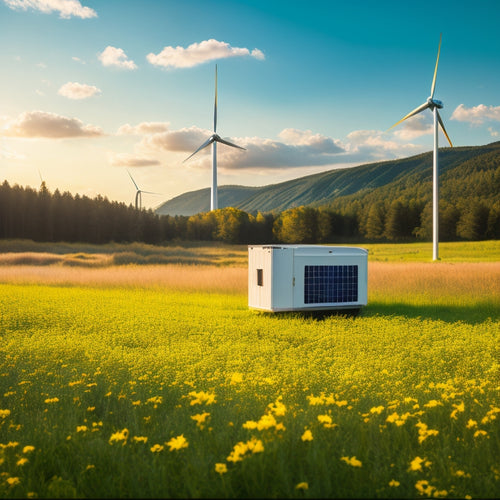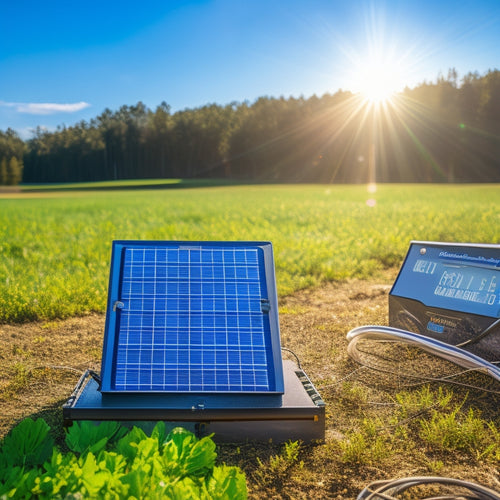
5 Best DIY Home Battery Backup Systems
Share
You're looking to create a reliable DIY home battery backup system that provides power independence and minimizes your reliance on the grid. To achieve this, you'll need to select the right components and design a well-integrated system. Start by choosing a high-performance battery like SimpliPhi Power or Relion Battery's lithium-ion options, which offer higher energy density and longer lifespan compared to lead acid batteries. Then, calculate your required battery capacity based on appliance power ratings and usage hours, and pair it with the right inverter size to support maximum power output. By considering essential safety features and affordable energy storage options, you'll be well on your way to creating a custom battery bank that meets your energy storage needs, and exploring these factors further will reveal even more opportunities for optimization.
Key Takeaways
- Select reliable, high-performance batteries like SimpliPhi Power or Relion Battery lithium-ion options for DIY solar projects.
- Calculate required battery capacity based on appliance power ratings and usage hours to ensure adequate energy storage.
- Choose the right inverter size by calculating total wattage of appliances and devices, and oversizing by 1.5 to 2 times for surge currents.
- Implement essential safety features, including fire-resistant enclosures, overcurrent protection devices, and secure electrical connections.
- Consider affordable energy storage options like repurposed used or refurbished batteries to optimize performance of renewable energy systems.
Top DIY Solar Battery Brands
When venturing into DIY solar battery backup systems, selecting the right brand can be a essential determinant of your project's success.
You'll want to evaluate brands that offer reliable, high-performance batteries that meet your specific needs. Lithium-ion batteries, for instance, offer several advantages over traditional lead acid batteries, including higher energy density, longer lifespan, and faster charging times.
Furthermore, maintenance frequency plays a significant role in extending the overall lifespan of deep cycle batteries, and monthly checks are recommended for ideal battery health.
Brands like SimpliPhi Power and Relion Battery offer high-quality lithium-ion batteries that are well-suited for DIY solar battery backup systems.
In contrast, lead acid batteries, offered by brands like Rolls-Surrette and Crown Battery, are more affordable but have lower energy density and shorter lifetimes.
Affordable Energy Storage Options
You'll find that affordable energy storage options are vital for making your DIY solar battery backup system a viable and cost-effective solution.
When exploring renewable energy sources, it's important to prioritize cost-effective solutions that optimize your system's performance. Think about purchasing solar solutions from online stores like Amazon and Home Depot for convenience and competitive pricing.
One approach is to think about lithium-ion batteries, which offer high energy density and a long lifespan. Another option is to repurpose used or refurbished batteries, reducing waste and saving you money.
Building a Custom Battery Bank
Selecting the right energy storage components is only half the battle; now it's time to focus on building a custom battery bank that integrates seamlessly with your DIY solar battery backup system.
You'll need to choose the right battery cell types, considering factors like depth of discharge, capacity, and lifespan. When it comes to daily energy usage, it's crucial to calculate the required battery capacity, factoring in appliance power ratings and usage hours understanding energy needs.
Lithium-ion batteries, for instance, offer high energy density and long lifetimes, but may require additional safety features.
When building your bank, consider the charging cycles your batteries will undergo. Will you need to accommodate frequent partial discharges or infrequent full discharges? Understanding these factors will help you design a battery bank that meets your specific energy storage needs.
Choosing the Right Inverter Size
Efficiency is paramount when it comes to utilizing the power of your DIY solar battery backup system, and the right inverter size plays an essential role in achieving it.
You'll need to determine the inverter capacity required to support your system's maximum power output. Calculate the total wattage of your appliances and devices, considering their individual power ratings and the number of hours they'll be used daily.
A general rule of thumb is to oversize the inverter by 1.5 to 2 times the calculated load to account for surge currents and system efficiency. This guarantees that your inverter can handle the maximum power demand, maintaining system efficiency and preventing overload.
Proper inverter sizing is vital for peak performance and extending the lifespan of your DIY solar battery backup system.
Essential Safety Features to Consider
As you commence designing your DIY home battery backup system, safety features become paramount to prevent electrical shocks, fires, and other hazards.
You'll want to guarantee your system meets fire safety standards, such as having a fire-resistant enclosure and proper ventilation to prevent overheating.
Additionally, you should implement battery maintenance protocols to prevent overcharging or deep discharging, which can lead to thermal runaway.
Install overcurrent protection devices, such as fuses or circuit breakers, to prevent electrical overloads.
Consider incorporating a ground fault circuit interrupter (GFCI) to protect against ground faults.
Finally, verify all electrical connections are secure and meet local electrical codes.
Frequently Asked Questions
Can I Use a Generator With My DIY Battery Backup System?
You can use a generator with your DIY battery backup system, but you'll need to verify the generator's power capacity matches your system's requirements, and choose a compatible generator type, such as an inverter-generator or a conventional generator with an external inverter.
How Long Does It Take to Charge a DIY Battery Bank?
When you craft a battery bank, you'll wonder, "How long till it's fully charged?" The answer hinges on charging efficiency, battery types, and capacity; for instance, a 48V 400Ah bank with 90% efficiency might take around 4-6 hours to fully charge from a 2000W source.
Are DIY Battery Backup Systems Compatible With Smart Homes?
When integrating a DIY battery backup system into your smart home, you'll need to guarantee seamless smart home integration and advanced battery management, allowing you to monitor and control your energy storage remotely, optimizing performance and efficiency.
Can I Add Batteries to My Existing Solar Panel System?
You can add batteries to your existing solar panel system, but you'll need to select batteries compatible with your setup, guaranteeing proper voltage and capacity matching, and follow installation tips like proper wiring and grounding to guarantee a safe and efficient integration.
Do I Need a License to Install a DIY Battery Backup System?
When installing a DIY battery bank in California, for instance, you'll need to comply with local building codes and electrical safety standards; typically, a licensed electrician is required, but you should check your state's installation regulations and safety considerations.
Related Posts
-

Sustainable and Eco-Friendly Generators for a Reduced Carbon Footprint
Sustainable and eco-friendly generators are perfect for cutting your carbon footprint and increasing energy efficienc...
-

Essential Hiking Lights for Safety and Fun
When you're hitting the trails, essential hiking lights are vital for safety and fun. A lightweight headlamp offers h...
-

Choosing the Right Solar Power Charge Controller
Choosing the right solar power charge controller is crucial for maximizing energy efficiency and extending battery li...


